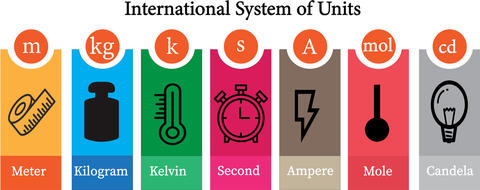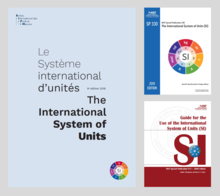Understanding Metric
As of August 16, 2023 the physics.nist.gov historic SI Units site has permanently retired. This page and complete Metric (SI) Program contains current SI information. Contact TheSI [at] nist.gov (TheSI[at]nist[dot]gov) with comments, questions or concerns.
Ready to Learn the Metric System? We are here to help!
Learning the SI (International System of Units, commonly known as the metric system) is easy. Begin with basics, including the 7 base units that define 22 derived units and using prefixes. Practice! Build proficiency and confidence making measurements using metric tools. Use reference points to develop an understanding of "how much." Estimation skills are key to sensemaking and checking for reasonableness of a measurement result. Learning metric is an interdisciplinary activity, so make connections to everyday life and career applications. You’ll find that writing with the SI is an effective way to communicate technical information. Take a NIST webinar or seminar to learn more! Explore professional development opportunities offered by the NIST Metric Program.
When you’re ready, explore the technical details NIST SP 330 and SP 811. Learn unit conversions between SI and non-SI units when necessary. Try the NIST Metric Trivia Quiz online or use the Alexa skill to test your knowledge and be on your way to thinking metric!

International Aspects of the SI
The International System of Units, abbreviated SI (from the French Le Système International d'Unités) was established in 1960 by the 11th General Conference on Weights and Measures (CGPM, Conférence Générale des Poids et Mesures). The CGPM is the international authority that ensures wide dissemination of the SI and modifies the SI as necessary to reflect the latest advances in science and technology. The CGPM is an intergovernmental treaty organization created by a diplomatic treaty called the Meter Convention (Convention du Mètre, often called the Treaty of the Meter in the United States), was signed in Paris in 1875 by representatives of seventeen nations, including the United States. There are now 64 Member States and 36 Associate States and Economies of the Meter Convention, including all the major industrialized countries. The Convention is the basis of all international agreement on units of measurement.
The Meter Convention also created the International Bureau of Weights and Measures (BIPM, Bureau International des Poids et Mesures) and the International Committee for Weights and Measures (CIPM, Comité International des Poids et Mesures). The BIPM has the task of ensuring worldwide unification of physical measurements, operates under the exclusive supervision of the CIPM, which itself comes under the authority of the CGPM. Suggested modifications to the SI are submitted to the CGPM by the CIPM for formal adoption.

To assist it in its broad spectrum of technical activities, the CIPM has set up a number of Consultative Committees (Comités Consultatifs) that provide the CIPM with information on matters that it refers to them for study and advice. Each Consultative Committee, the Chairman of which is normally a member of the CIPM, is composed of delegates from national metrology institutes (NMI) such as NIST, specialized institutes, and other international organizations, as well as individual members. The Consultative Committee for Units (CCU, Comité Consultatif des Unités) advises the CIPM on matters dealing with the SI. In particular, the CCU helps to draft the BIPM SI Brochure, of which NIST Special Publication (SP) 330 is the U.S. version. NIST Special Publication (SP) 811 helps authors review the conformity of manuscript and other documents with proper SI usage and the basic principles concerning quantities and units.
EXPLORE THE METRIC PROGRAM
Becoming Familiar with SI | Everyday Estimation | Metrication FAQs | Prefixes | Metric Kitchen | SI Education and Training | SI Publications | Understanding Metric | Writing with Metric Units | National Metric Week | NEST-R (STEM Registry) | NIST Education Resources
Contacts
-
Metric Program

